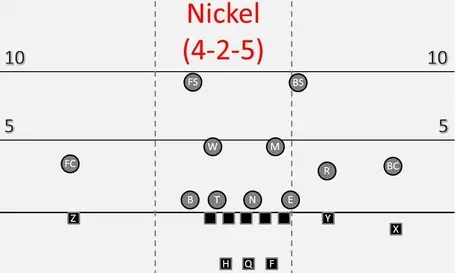What is the “Two-fer” defense? It is simply looking at what everyone else calls a 4-2-5 defensive alignment, and truly following the textbook definition of how to define an alignment. Most coaches would state that the first number indicates how many defensive linemen have a hand-down, and that would mean that the defense that Coach Boles is going to review is actually a 2-4-5!
Since I have had fun coining our own names to defenses in the past (The 3-Duck-Chuck) it made sense to make it easy for us fans, and call it Oregon’s “Two-fer” 2-4-5 defensive alignment. We will see it often in passing situations, so let’s learn more about it and what to watch for this fall. Charles Fischer
So far, I’ve been writing on individual plays utilized within Coach Willie Taggart’s offense. Today I’m going to touch upon the basics of a defensive alignment that Coach Jim Leavitt likes to deploy during passing situations. That alignment is known as the 2-4-5.

Leavitt’s 2-4-5 defense.
For starters, I believe the use of this alignment is dictated by the base that Coach Leavitt uses. The 3-3-5/3-4 utilizes three large linemen to take up blocks and collapse the pocket; not so much to rush the passer. Because of this, on passing downs, Leavitt has to find a way to get more speed and pass rushing presence on the field.
A few things will happen at Oregon, when transitioning from base into the 2-4-5. First, the nose tackle will be taken off the field and the two defensive ends will slide into the middle, playing defensive tackle positions. Next, the two outside linebackers in the 3-4 will basically play as standing defensive ends. Lastly, a third cornerback will be subbed in to play the nickel position.

The 4-2-5 alignment.
We need to understand that the title, 2-4-5, strictly describes the personnel of the alignment in this situation. If you’re thinking of the visual alignment of the defense, it would be more akin to a 4-2-5 (Diagrammed above). In fact, the 2-4-5 mimics the 4-2-5 in a lot of ways, but it also adds another level of deception to blitzes and coverages with the linebackers playing as defensive ends.
To me, the coolest part of this alignment is the variety of zone blitzes that can be deployed. Essentially, zone blitzes are used to confuse the offensive line by trading the responsibilities of the defensive line and the linebackers/defensive backs. What I mean by trading responsibilities is that linebackers and defensive backs will blitz to rush the passer, while select defensive linemen drop back into coverage.
Above, you can see an example of a zone blitz from Leavitt’s 2-4-5 at Colorado. Here the Buffs decide to use a nickel blitz and drop the OLB towards the top of the screen into under coverage. This switch in responsibility confused the offensive line enough to let No. 47 through for a clean sack. Of course, these zone blitzes can be utilized by teams playing with four true linemen, but in the 2-4-5, the outside linebackers have a distinct advantage in the area of coverage skills.
The 2-4-5 is a great defense all around. It’s going to be awesome seeing Oregon attacking on passing downs with these new schemes. Leavitt was fantastic at turning Colorado’s defense around, and his utilization of the 2-4-5 nickel was a big part of that.
I cannot wait to see the havoc Oregon brings with their new “two-fer” defense this fall.
Coach Eric Boles
Newark, Ohio
Top Photo Credit: From Video
Eric resides in Central Ohio, just outside the capital city of Columbus. He is a former offensive assistant and return game coordinator for the Ohio State – Newark/Central Ohio Technical College Titans football program.
He is an OSU-N graduate, having completed a Bachelor of Arts program in psychology.

